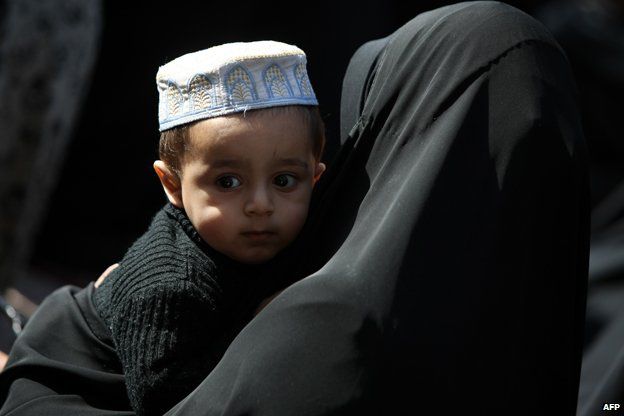How come Iraq's population has been rising?
- Published

The UN says that at least 7,818 civilians and 1,050 members of the security forces were killed in Iraq in 2013, the highest numbers for years. But despite this - and despite a decade of bloodshed - the UN also says the overall population has been growing steadily. How can this be?
Estimates of how many people have died in Iraq since foreign troops entered the country in 2003, vary widely - from just over 100,000 to more than a million.
The problems are easy to understand. Many deaths will certainly go unreported, while others may be counted twice. But there's more to it than that.
"The numbers are so different because they are counting different sorts of things," says Dr Glen Rangwala, of the University of Cambridge's Politics and International Studies department.
He sees two main ways of doing the sums. You can add up every mention of a violent death during the conflict. Or, alternatively, you can compare the overall death rate, before and after the invasion.
The first method involves collecting figures from police, mortuary, or military records - even press reports. This is the technique employed by the Iraq Body Count, which estimates that between 120,000 and 133,000 civilians have died since 2003.
The second method involves carrying out surveys of thousands of homes across Iraq, and asking about all deaths in the household, not just violent deaths.
"Not all deaths that occur in a conflict are caused by immediate acts of violence," says Rangwala. Damage to infrastructure, or difficulties caring for the sick could result in more people dying, he points out.
This method produces much larger figures, but some studies carried out in this way have been criticised - for failing to ensure that no deaths are counted twice, for example.
Rangwala personally reckons that a million is an overestimate. He thinks a study that recently came up with a figure in the region of half a million may be closer to the truth.
But despite so much loss of life, Iraq's population appears to have risen significantly since 2003.
The UN estimates that there were around 25 million people in Iraq in 2003 and there are about 33 million people in Iraq today - a rise of almost a third in a decade.
Again, arriving at these figures is not straightforward. There has not been a census in Iraq since 1997 - and even that did not cover the whole country. Instead, researchers have had to extrapolate population estimates from surveys. For this reason, there is some uncertainty about the UN figures.
If the country's population has been rising, it has done so despite:
- a rise in the death rate - which is the main reason for those big numbers that result from the second method of counting the dead
- an exodus of refugees, put by the UNHCR at two to three million since the start of the war
How can this be possible?
According to Patrick Gerland from the UN's Demographic Estimates and Projections Section, DESA, it's quite simple - there have been many more births than deaths.
"A lot of families have a relatively large number of children, about four on average, or more," says
"The end result is that every year you keep adding about 600,000 more people in the country."
In the past infant mortality was high, but this is no longer the case.
Although Iraq's fertility rate is high compared with European countries, it has been dropping. A generation ago, it was almost double what it is today.
It is likely to drop further if life in Iraq settles down. If you compare with Iraq with its neighbour, Iran, there is quite a striking contrast. An average Iranian family has two children, compared to Iraq's four.
This is because while Iraq has been going through decades of uncertainty and war, Iran has been able to modernise its public health system.
The figures from Iran are also more robust - three censuses have been carried out in the last two decades.
"After the Islamic Revolution, Iran had a very, let's say, proactive family policy, but especially with a strong component on public health, to help mother and children," says Gerland.
"For example, when a young couple wants to get married they have a one-hour counselling session with a medical doctor who gives a briefing about health, but especially family planning, to both the future husband and the future wife."
Gerland also says that women in Iran have had better access to education and professional opportunities that has in part lead to falling birth rates.
"The challenge for a country like Iraq with a fast growing population is for the country to keep up with providing health, education, housing, and jobs among other things," he says.
Until this happens, the birth rate is likely to remain high - and the population is likely to continue rising.
Listen to More or Less on BBC Radio 4 and the World Service, or download the free podcast
Follow @BBCNewsMagazine on Twitter and on Facebook